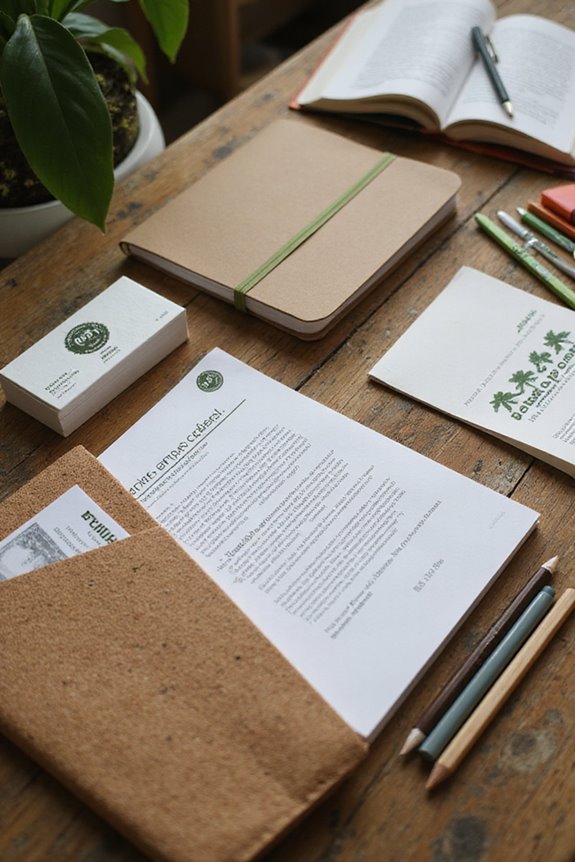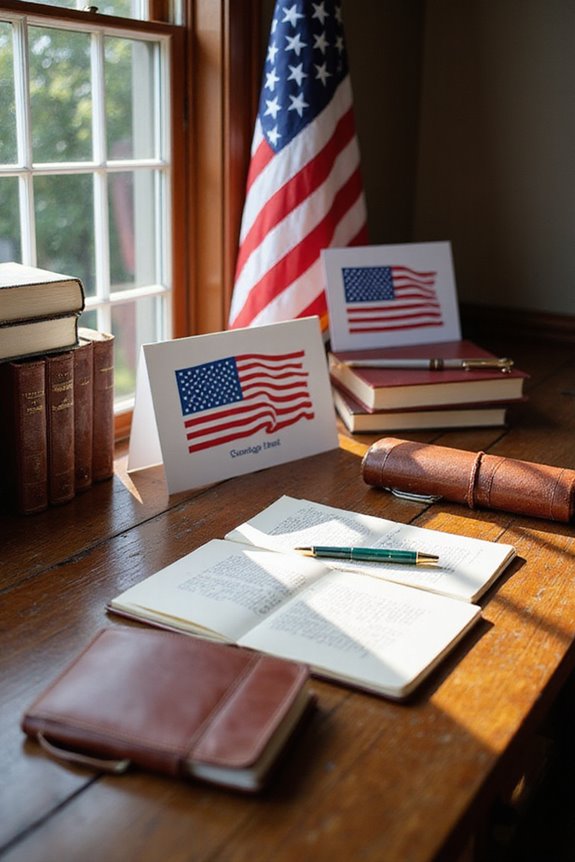Eco-friendly political stationery options are essential for sustainable campaigns. They utilize materials like 100% post-consumer recycled paper, bamboo, and biodegradable substances. These choices help reduce waste and pollution, appealing to environmentally-conscious voters. Sustainable production processes, such as double-sided printing and using vegetable-based inks, enhance waste reduction. By adopting these practices, we foster community engagement and enhance our public image. If you’re interested in expanding your understanding of these solutions, read on to discover more options.
Key Takeaways
- Utilize recycled materials like 100% post-consumer paper to reduce waste and promote sustainability in political campaigns.
- Incorporate plant-based options such as bamboo and seed paper for eco-friendly stationery solutions.
- Implement double-sided printing and minimalist designs to conserve resources and minimize environmental impact.
- Engage the community with workshops and campaigns to promote awareness of sustainable stationery practices.
- Emphasize digital strategies to reduce physical materials while enhancing voter engagement and reducing environmental footprints.
Importance of Eco-Friendly Stationery in Political Campaigns
The importance of eco-friendly stationery in political campaigns cannot be overstated, particularly as we navigate environmental challenges. By utilizing sustainable materials, we can greatly reduce waste and pollution associated with traditional stationery.
- Eco Conscious Messaging: Implementing eco-friendly options reinforces our commitment to environmental issues, appealing to voters who prioritize sustainability. Additionally, national elections have been shown to generate massive amounts of waste, highlighting the need for sustainable practices. Using eco-friendly stationery can also enhance workspace efficiency, creating a more organized and professional image for campaigns.
- Voter Engagement: Using green materials enhances our public image, fostering stronger connections with constituents.
Moreover, eco-friendly stationery aligns with increasing regulatory pressures, ensuring compliance and avoiding fines. As we shift toward more sustainable practices, we not only minimize our environmental footprint but also demonstrate leadership in promoting responsible resource usage. This approach sets a powerful example for constituents, encouraging broader community participation in environmental stewardship.
Types of Eco-Friendly Materials Used

Incorporating eco-friendly materials into our political stationery not only reinforces our commitment to sustainability but also offers practical benefits. Here are some types of materials we can use:
- Recycled Materials: Primarily made from 100% post-consumer recycled paper, these options considerably reduce resource consumption and minimize landfill waste.
- Agricultural Residues: Paper made from byproducts like rice straw and sugar cane bagasse utilizes green energy, resulting in a 47% lower environmental impact compared to tree-based paper. This practice helps save 77,040 trees from being cut down.
- Plant-Based Alternatives: Bamboo and cork are excellent options for various stationery items, while seed paper can be planted after use.
- Biodegradable and Upcycled Materials: These materials repurpose waste and decompose naturally, further supporting our sustainability goals.
Sustainable Production Processes

Sustainable production processes are essential for developing eco-friendly political stationery, as they directly influence both environmental impact and resource conservation. By focusing on sustainable sourcing, we can utilize materials like agro-waste, recycled papers, and bamboo. Key practices include:
- Pulping: Transforming collected materials into pulp for paper.
- Production efficiency: Implementing double-sided printing and minimalist designs to minimize waste.
- Biodegradable finishing: Enhancing the end product’s environmental friendliness.
Utilizing vegetable-based inks and natural colorants reduces toxic chemicals, further supporting sustainability. Moreover, companies seek suppliers with certifications like FSC and PEFC to guarantee responsible sourcing. By adopting these methods, we can considerably decrease our ecological footprint while producing high-quality, eco-friendly stationery options for political purposes. Additionally, focusing on genuine sustainability can help ensure that the materials used have a minimal environmental impact. Furthermore, understanding political institutions plays a crucial role in shaping policies that promote eco-friendly practices in the industry.
Environmental Benefits of Choosing Eco-Friendly Options

Choosing eco-friendly options for political stationery offers a range of environmental benefits that align with our commitment to sustainability. By selecting these products, we can achieve the following:
- Reduction in Deforestation: Using recycled materials decreases the demand for virgin wood pulp, preserving forests.
- Less Pollution: Eco-conscious design often results in lower emissions during production, contributing to cleaner air.
- Conservation of Resources: Sustainable messaging emphasizes the use of biodegradable materials, conserving natural resources. Additionally, eco-friendly products like plantable stationery provide an innovative solution for post-use planting, further enhancing their sustainability.
- Minimized Waste: Biodegradable stationery reduces landfill contributions, promoting responsible disposal practices.
- Support for Biodiversity: Plantable stationery encourages growing plants, enhancing local ecosystems.
Examples of Eco-Friendly Political Stationery Brands

When it comes to eco-friendly political stationery, several brands stand out for their commitment to sustainability and innovation. Here are some notable examples:
- Papier: A British brand offering personalized eco-friendly stationery, using sustainably sourced materials and collaborating with global artists for unique designs.
- Paper Culture: This California-based brand specializes in DIY cards and saves-the-date materials, using 100% post-consumer recycled paper and planting one tree per order. Their commitment to environmentally friendly materials ensures that their products are both stylish and sustainable.
- Earth Greetings: An Australian brand focused on 100% recycled stationery, employing non-toxic inks and a carbon-neutral business model.
- Minted: Known for stylish, customizable products, Minted uses 100% post-consumer recycled paper and supports independent artists.
- Heart and Parcel: A small business emphasizing ethical sourcing, making charming products from organic and recycled materials. With the increasing awareness of plastic pollution, these brand comparisons provide great design inspirations for eco-conscious political campaigns.
Biodegradable and Compostable Campaign Materials
As we explore the importance of eco-friendly political stationery, it’s also essential to contemplate biodegradable and compostable campaign materials.
- Biodegradable Signage Benefits: These materials decompose into carbon dioxide and water, conforming to ASTM D6954-04 standards. They considerably reduce non-recyclable waste and avoid landfill pollution. One notable option is biodegradable yard signs, which are 100% compostable and provide a sustainable solution for political campaigns. Additionally, high-quality materials can enhance the longevity of biodegradable signs, ensuring they remain effective for the duration of the campaign.
- Compostable Materials Challenges: Effective degradation often relies on industrial composting facilities, which may not be accessible everywhere. Additionally, some biodegradable materials have varying durability, making them less effective for long-term visibility. Proper disposal involves separating biodegradable components from non-biodegradable parts, and contamination from inks can hinder compostability.
The Role of Local Production in Sustainability
Local production plays an essential role in enhancing sustainability by:
- Supporting Local Artisans: This practice boosts our economy and fosters community development, creating jobs and empowering local talent.
- Reducing Carbon Footprint: By minimizing transportation, we decrease carbon emissions associated with logistics, making our practices more eco-friendly. Additionally, this approach aligns with the growing consumer demand for sustainable products that reflect environmental values.
- Ensuring Ethical Practices: Proximity allows for better oversight, ensuring fair labor conditions and ethical manufacturing methods.
- Increasing Community Engagement: Local production encourages us to participate actively in sustainability efforts, fostering a sense of shared responsibility.
- Fostering Innovation: Local artisans often experiment with sustainable materials, leading to unique and environmentally friendly stationery options.
Through these efforts, we can create a more sustainable future for political stationery.
Enhancing Campaign Branding With Eco-Friendly Stationery
Enhancing campaign branding with eco-friendly stationery not only promotes environmental values but also strengthens a candidate’s image in the eyes of voters. By utilizing sustainable materials like FSC-certified paper stocks for brochures, we effectively align our brand messaging with eco-consciousness. Additionally, incorporating MUJI stationery can provide high-quality, minimalist designs that resonate with a modern audience.
Key strategies include:
- Custom Designs: Tailored visuals integrate eco-friendly themes, enhancing brand recognition.
- Recyclable Materials: Lightweight signs and banners minimize waste while maintaining visual impact.
- Durability: Weatherproof products guarantee longevity and repeated use, reinforcing our commitment to sustainability. Additionally, our commitment to FSC-certified paper signifies a responsible approach to sourcing materials.
These practices not only support visual storytelling but also create a unified brand identity. Engaging voters through eco-friendly stationery fosters a deeper connection to our campaign, highlighting our dedication to environmental responsibility while enhancing overall brand consistency.
Engaging the Community Through Sustainable Choices
What steps can we take to engage our community through sustainable choices during our campaign? First, we can form community partnerships with local organizations that promote eco-friendly practices. By working together, we can host environmental workshops to educate voters about sustainable materials and their benefits.
- Utilize biodegradable materials for campaign posters to reduce waste.
- Promote recyclable options for campaign stationery, minimizing plastic use.
- Implement efficient waste management systems to keep our community clean.
- Launch public awareness campaigns to highlight our commitment to sustainability.
- Use digital strategies, like social media, to enhance voter engagement and reduce physical material needs. Additionally, we can address the issue of election campaigning contributing to significant waste problems and encourage local candidates to adopt more sustainable practices.
These actions not only support the environment but also strengthen our ties with the community.
Frequently Asked Questions
How Can I Verify a Brand’s Eco-Friendly Claims?
To verify a brand’s eco-friendly claims, we should look for evidence of sustainable sourcing and brand transparency. Checking third-party certifications and detailed reports can help us guarantee their claims are authentic and trustworthy.
What Are the Costs Associated With Eco-Friendly Stationery?
When we analyze costs, budget considerations reveal that eco-friendly stationery often carries higher initial expenses. However, we should weigh long-term savings and environmental benefits against these costs for a more thorough understanding of our investment.
Are There Certifications for Eco-Friendly Stationery Products?
There’re various green certifications and eco labels we can look for to verify products are environmentally friendly. These include FSC, GOTS, and Green Seal, which guarantee responsible sourcing and sustainable practices in manufacturing.
How Can I Recycle Political Campaign Materials After Use?
After elections, we can recycle political campaign materials by creatively recycling signs and brochures. Repurposing materials for art projects or community use not only reduces waste but also inspires others to follow eco-friendly practices.
What Are the Best Practices for Sourcing Eco-Friendly Stationery?
When sourcing eco-friendly stationery, we should prioritize sustainable materials and ethical sourcing. By selecting recycled content and biodegradable options, we can minimize our environmental impact while supporting responsible practices in the stationery industry.







